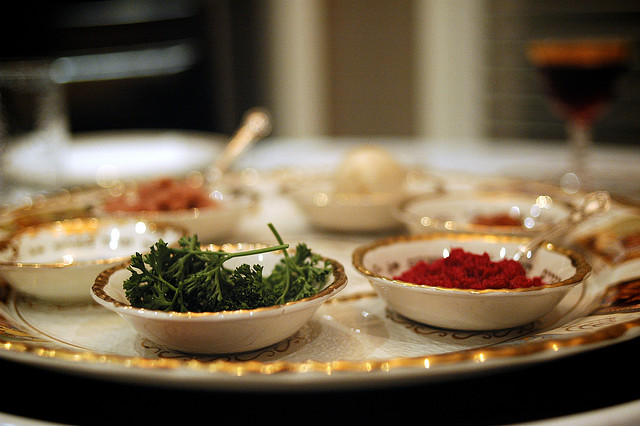
Dayenu. Dah-yeh-new.
Every Passover I learn new words. This week I attended my second Seder, the Jewish ceremony consisting of rituals and dinner among friends and family. Each time I enjoy a holiday with my fiancée’s family, I expect to learn a new word or two. First, during my college years in New York City, came kvetch and kvell; next came mitzvah. The latest, acquired at her family’s home in suburban Philadelphia, means, roughly, “it would have been enough.”
It’s not that Elizabeth’s family is deeply rooted in Jewish tradition. They celebrate Hanukah and hold Bar Mitzvahs but do not observe the Sabbath. Some members of the family–nuclear and extended–identify more with the Jewish faith than others do. The lexicon arises because they are integrating me into their family, and I am new to it all. When trying to accommodate someone to a new environment, go for detail: lob your guest some new vocabulary, of course, add some family history and some extra tidbits about your second cousin’s poodle. Do not forget that hilarious story about the time Uncle Ronny forgot daylight savings time and arrived an hour late to his own wedding!
During my first Seder, I worried I stood out too much among my new girlfriend’s family, with my French goy background and ignorance of this holiday. I was raised atheist–my family has a tradition of eating rabbit, of all things, on Easter. And I did not have many Jewish friends growing up in Paris, London, Tokyo and New York. I’ve only ever attended two Bar Mitzvahs, and I think I learned the expression “mazel tov” from a Mel Brooks movie.
As far as Seders are concerned, I knew Elijah was involved, but I never knew who exactly he was. I worried about understanding all the Haggadah’s references. I tried to memorize the names of the various elements that make up the ritual meal–there’s your pharosis, moran and happy cumin, I remembered (falsely). I have to admit I was impressed with myself.
I know better now. This year, I have embraced my ignorance, so I am no longer nervous. The obliging Goldberg-Black-Simins family–a complex assortment of divorces and step-children–all pitch in to help me understand what’s happening. As we sit down to begin the ritual, I observe the extended family take their places. The leader of the service helps each participant find the spot at the table that makes the most sense. I expertly open the Haggadah from the back.
I am learning slowly and adapting rapidly. I imbibe in new culture and kosher wine. I have a bottle of Pinot on the side, adding my French twist to the proceedings.
We read that if God had helped us out of slavery but not given us land, the Torah and a temple, “it would have been enough.” Dayenu.
The scripture poses the question, “Who knows one?” This introduces a tale that we must recite in turn, each participant adding a new theme until we arrive at 13 lines. The song lists various symbols and vignettes of Jewish tradition. Guess who lands on 13? I’m told to recite everything in one breath. I’m not sure if this pulmonary feat is another nod to the Jewish people’s desert plight or a family variation.
The Goldberg-Black-Siminses have been hard at work preparing the feast, cleaning the house, and setting the table in pink spring themes. We are sitting at the dining room table, where I have eaten only two or three times over the years. The traditional Seder plate in the center contains just one helping of each key ingredient; traditionally, everyone serves themselves from this platter, but to make things easier, my future mother-in-law has decided to serve each person individual plates with the traditional egg, herbs and so on. Traffic piles up in the kitchen as everyone seeks extra helpings of the exquisite matzoh ball soup. Sucking up to my future in-laws has never been so easy.
The highlight of this Seder is the individual quirks. One participant reads the scripture in its original Hebrew. Another has highlighted specific parts she wants to read. The youngest has been eyeing her grandfather all night in case he sneaks off to hide the afikoman, the half-piece of matzoh she must find to claim a prize. The importance of the Leader shows in how he orchestrates–my two Seder experiences were completely different because of the unique experiences and meanings the different Leaders brought to the table.
Finally it is time for almond cookies and chocolate chip meringues, another supplemental–and somewhat salacious–tradition. These may be the best yet. I have come to realize, as we bite into the pièces de résistance, that the main reason these people go to such lengths to prepare a Seder is not to celebrate freedom from Egyptian despots, but to celebrate being a family.
By the end of the night I am full, tipsy and happy. I have survived the pressures of an event with my beloved’s extended family and had an enjoyable evening. But I have also been transported–touched by tradition that first appeared alien, but that even a goy can intuitively understand.
Dayenu.
Tom Faure’s work has appeared in The Journal News of White Plains, NY, the Chattanooga Times-Free Press in Tennessee, and Asbury Park’s Splash of Red literary magazine. He lives in Astoria, NY.
*Photo courtesy of revenante.




Send A Letter To the Editors